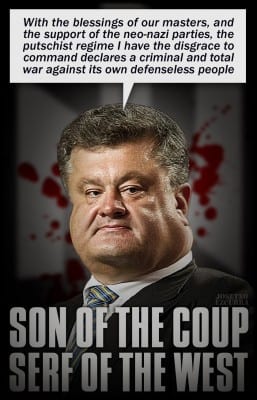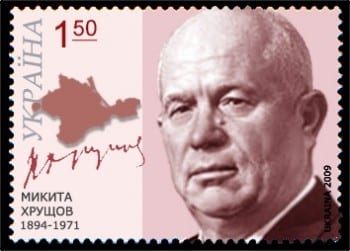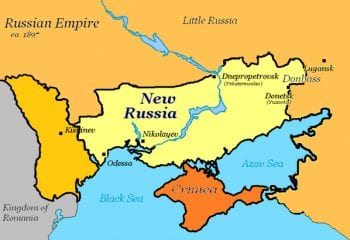HISTORY DOES REPEAT ITSELF
THE RUSSIA DESK | GAITHER STEWART
NOVOROSSIYA, UKRAINE AND CRIMEA
(Rome)
[I]t has been said that a nation is simply the spiritual body that a people acquires during the course of its history.
Novorossiya or New Russia, so absent in mainstream media and so present in alternative news sources today, is popularly believed to be a fleeting matter, simply a new name created ex-novo for effect by the local militias of southeastern Ukrainians today fighting and defeating the Ukrainian regular army troops invading their territories. In doing so the people of Novorossiya are also shattering the dream of American President Obama. The truth is the people of this region are closely linked to the history of their lands.
According to Alexander Zakharenko, field commander and Prime Minister of the Donetsk Peoples’ Republic (DPR) in southeastern Ukraine speaking at a recent press conference, invaders from West Ukraine run or surrender at the first shot. The American-financed troops, conscripted by force by the puppet state in the Ukrainian capital of Kiev, simply don’t measure up to the warriors of the southeast Ukraine who are defending their lands, their cities and villages, and their families. The point is that the regular army troops are demotivated and scared and want to return to their homes in West Ukraine. Besides, many Ukrainian soldiers do not want to shoot at their fellow countrymen. Therefore they either desert to the so-called Separatists of the DPR, or flee.

For three centuries the West has assaulted Russia with regularity, in almost 50 year intervals, always seeking to contain her, conquer her, occupy her, exploit her and above all destroy her.
However, the reality is that Russia is not Oriental, but also part of Europe, in this case however, a Europe of the East. Despite Arab influences in Europe, Cervantes, Weidlé noted as an example, was not a Moor, nor Pushkin a Mongol. In the same manner the centuries of Tartar occupation of Russia, likewise Lenin with his face of Mongolian cast was not a Tartar. Nonetheless, today Russia’s eyes have turned eastwards because of pressures from the West.
Still, the geographical situation of Russia has pointed the path of its expansion and the very shape of the empire, but not the direction its cultural development has taken. Weidlé believed that the invasion of Russia by Asian Tartars changed the very roots of Russia, yet such non-European elements do not really belong to her history but to the raw materials of her nature. The Russian language shows certain analogies to the languages of Turco-Tartary; but Russian developed from Greek, to which was added the influence of the literary languages of Western Europe. The Asiatic influences that appear from time to time in Russia have thus far been fleeting. Here, again, its geographical position on the map assumes important historical importance.
When Tsardom finally collapsed in the early 20th century, it had crushed one revolutionary movement after the other during most of the 19th century. Trotsky wrote in his autobiography, My Life, that “the best elements of that generation went up in the blaze of dynamite warfare” (that is, in the blaze of revolutionary terrorism). Tsardom fell to continuing revolutionary fever spread throughout Russia and to the pressures of WWI and the huge losses Russia suffered. In fact, it was the very force of the history of European capitalism and the Russian Revolution that changed everything in Russia.

The Novorossiya territory is internationally considered as sovereign territory of the Ukrainian state. Western media write of a southeastern Ukraine run by “terrorists” and moreover backed by the great “Satan” of Russia, Vladimir Putin. Despite Washington’s frustration because of the failure to bring Ukraine into NATO, its neocons remain intent on intervening in Ukraine against Russia, subduing the Novorossiya independence movement, and placing US/NATO Lily Pad-style military bases along Russia’s borders.
THE CRIMEA
On a trip backwards through the events of over 150 years we arrive at the Crimea recently annexed by Russia and the Crimean War fought by Russia against the intervention of the first major coalition of Western powers in alliance with the Ottoman Empire to attack Russia. No one should believe easy accusations of Russian guilt in the Ukraine crisis. Western intervention against Russia is an old story. A tradition that has continued until today.
Russians had inhabited the territory of southeastern Ukraine between the state of Ukraine and Crimea in the 19th century, shortly after the Crimean War (1853-55) which, by the way, some historians call the real World War I. Also those Russians of the 19th century referred to their home territory as Novorossiya, New Russia.
The descendants of those first colonists in Novorossiya in today’s southeastern Ukraine have declared their independence from the Ukraine of the West and its capital of Kiev and established the “Donetsk Peoples’ Republic”. Last May it joined with the “Lugansk Peoples’ Republic” to form a new Novorossiya as a confederal “Union of Peoples’ Republics”. The lands of Novorossiya are rich in natural resources—light and heavy industry, minerals and agriculture—and borders on both Russia and on the once again Russian Crimean peninsula and other Russian lands such as Transnistria quite near Odessa.
Who today knows much about the almost forgotten Crimean War? In fact that war is often confused with the second Allied Intervention in Russia against the new Communist regime, just the memory of which triggers knee-jerk reactions in Western capitals, especially in Washington where many people and their leaders tend to think of Russians as Communists who fall outside the New World Order. The very idea of Novorossiya constitutes a menace to US strategy for world hegemony. After the Russian Revolution of 1917 while the new regime was struggling for its very survival, the Russian Civil War broke out which pitted the reactionary and privileged Whites—who in general favored the ancien regime of the Tsars—against the Bolshevik-led Reds. The already difficult situation of the revolutionary forces was then further complicated by the second Allied intervention in Russia within a century.
So here a few words about the Crimean War are in order. The Crimean War began as another of the series of 19th century wars between the crumbling Ottoman Empire on the one hand and an expansive Russia seeking an exit from the Black Sea into the Mediterranean on the other. The key part of that war began in September 1854 when the coalition of Britain, France, the Ottomans and later the small Kingdom of Sardinia, the core state of the future Italy, landed troops in Russian Crimea located on the north shore of the Black Sea.
As the historical name indicates, most of the war was fought in Crimea. The Allies began a year-long siege of the Russian fortress of Sevastopol. However, besides Sevastopol, the Anglo-French fleet attacked areas on the adjoining Azov Sea and in the Caucasus. In a forgotten part of the forgotten war, the Allied fleet, obsessed with the destruction of the Russian navy, sailed also to the Baltic Sea to attack the proudest bastion of the Russian Bolshevik, the seaport of Kronstadt near St. Petersburg and to destroy the Russian fleet stationed there. Three British warships then left the Baltic for the White Sea where they spread destruction. Naval skirmishes also occurred in the parts of the Far East where the Anglo-French naval force besieged Russian forces and attempted a land invasion around the Kamchatka Peninsula.
The major Crimean battle fought at Balaclava in the Crimea was commemorated by the great English poet, Alfred Lord Tennyson, in his The Charge of the Light Brigade which, by the way, school children in Great Britain often learn by heart. Tennyson’s poem, published in December of 1854 in The Examiner first praises the bravery of the Brigade:
“When can their glory fade?
O the wild charge they made.”
At the same time the poet then mourns the futility of the charge, the futility of war in general:
“Not tho’ the soldier knew
Someone had blunder’d.
Finally, on September 11, 1855, the Russians blew up their forts and sank their ships and evacuated Sevastopol, defeated by western armies. They had won the battle of Balaclava but lost the war.
Concerning the causes of the Crimean War, British historian A.J.P Taylor notes that there were deeper causes than blocking Russia’s historical need for an exit from the Black Sea through control of the strait Dardanelles strait near Istanbul:
“The Crimean war was predestined and had deep-seated causes. Neither Nicholas of Russia nor Napoleon III of France nor the British government could retreat in the conflict for prestige once it was launched. Nicholas needed a subservient Turkey for the sake of Russian security; Napoleon III needed success for the sake of his domestic position; the British government needed an independent Turkey for the security of the Eastern Mediterranean….Mutual fear, not mutual aggression, caused the Crimean war.”
In the eyes of some historians the major point is that the Allies fought the Crimean war not in favor of the Ottoman Empire, “the sick man of Europe”, but against Russia. Britain feared Russia would modernize its navy and threaten British naval supremacy in the world and was intent on giving Tsarist Russia a lesson. The war might have ended earlier but war fever had been whipped up by the press in Britain and France so that politicians were afraid to propose ending the war.
But with the passage of time public sentiment in Britain changed to anti-war, and France which had suffered major casualties wanted peace. The signing of the Treaty of Paris brought an end to the war but not to Western hostility to Russia. The Black Sea was demilitarized, which weakened Russia, no longer a naval threat to Britain. Sevastopol and other occupied cities were returned to Russia which however had to give up some of its Danubian principalities and its aspirations to unite with its Slavic cousins in Bulgaria and Serbia still under the yoke of the Ottomans.
TSARIST RUSSIA
Meanwhile in Russia great events, world-shaking events, were taking place. Yet for Russia the two preceding centuries of her history were more tragic than glorious. The history of the now more than two centuries was marked by the mingling of Russia and the West, above all by the drive of the West into Russia which ended in the many Western interventions in Russia several of which, as we have seen, were armed interventions that in the long run aimed at the total conquest of that new world. Weidlé notes that though Russia’s history had been full of movement, rich in events and achievements, it had never solved the problem of the integration of the various social groups into a common life. This integration, by the way, was also lacking in ancient Russia, in the new Soviet Russia and again today in a new Russia. Yet Russia attained a blend of order and disorder that fostered the normal development of a nation. In Russia that blend led directly to the Great Russian Revolution, perhaps because of the degree of those old separations of the masses from the hierarchy of the elite. Western observers have noted how in Russia the governing class and the people seem quite distinct. In fact, there have traditionally been two cultures in Russia: that of a very small elite and that of the masses, which lasted until the revolution and the enormous changes it wrought. When thinking of the Russian revolution, you should keep in mind that, desirable or not it eliminated the old elite and formed a new one.
In the decades following the Crimean War revolutionary fever was growing in Russia. Finally Russian Socialists and Social Revolutionaries led the 1905 revolution that forced Tsar Nicolas to grant the establishment of the Duma, a legislative assembly, which marked the start of a kind of Constitutional Democracy and weakened the total power of the Tsarist regime. It seemed that Russia was truly destined to be part of Europe. Trotsky notes that despite the counter-revolution, an industrial boom came in 1910 and with it the strikes. The shooting of workers in 1912 gave rise to protests all over the country and by 1914 beautiful St. Petersburg had become an arena of workers’ barricades. It has been said that governments come and go but the police (soldiers too) remain. Moreover, policemen are conservatives because of the nature of their work. Trotsky knew that new ideas (he was referring to Socialism) always come early.
In reference to the 1917 revolution Trotsky wrote a paragraph that reminds me of Giordano Bruno four centuries earlier, which, I believe, is well worth quoting. I made a very few cuts for purposes of brevity:
Marxism considers itself the conscious expression of the unconscious historical process. But the unconscious historical process, in the historico-philosophical sense of the term, coincides with its conscious expression only at its highest point, when the masses break through the social routine and give victorious expression to the deeper needs of historical development. At such moments the highest theoretical consciousness of the epoch merges with the immediate action of the oppressed masses that are furthest away from theory. The creative union of the conscious with the unconscious is what one usually calls ‘inspiration’. Revolution is the inspired frenzy of history.
In fact, as Trotsky had predicted there began a series of mutinies in the navy and the army. During the revolution, every fresh wave of strikes and of the peasant movement was accompanied by mutinies in all parts of Russia. Already during the revolution some Western Ukrainians became aware of the dangers to the central government in Kiev of the movement for Donetsk separatism from the Ukrainian state. The Novorossiya idea had never died.
UKRAINE – A People but No Nation
Ukrainian Prime Minister Arseny “Yat” Yatsenyuk announced to a conference of European politicians meeting in the Ukrainian capital of Kiev that “Putin wants to destroy Ukraine as an independent nation and restore the Soviet Union.” He added that his country is in a state of war and that Putin is the aggressor. “Putin’s aim is not just to take Donetsk and Lugansk. His goal is to take the entire Ukraine. Putin is a threat to the global order and to the security of Europe.” Yat does not want Russian to become the second state language. He wants European Union membership for Ukraine and opposes Ukrainian membership in the new Customs Union of Belarus, Kazakhstan and Russia, which Yatsenyuk believes would mean the restoration of the Soviet Union, albeit in a slightly different form and name. He accuses Russia of wanting to construct a new Berlin Wall, this time on the western border of Ukraine and the European Union. Before Russia annexed the Crimea, Yatsenyuk said the decision of Ukrainian membership in the European Union should be decided by referendum.
Ukraine watchers were taken by surprise when Russian President Vladimir Putin used the term “Novorossiya” to refer to some regions in southeastern Ukraine: Kharkiv, Luhansk Donetsk and Odessa. “They were not part of Ukraine in Tsarist times, they were transferred in 1920. Why? God knows.” His idea could have been to ready Ukraine for absorption of those territories into Russia. At the same time “Novorossiya” is also the slogan of pro-Russia activists in southeastern Ukraine where people are chanting the Novorossiya theme. Such an event today would devastate the already shaky economy in Kiev with no money in its coffers. After all irredentism is the effort to reunify lost territories inhabited by ethnic kin with territories also inhabited by ethnic kin. Most certainly the USA, the EU and the IMF would not consider bailing out a country much, much worse off than was Greece. And if came down to the wire, sanctions and resolutions would not stop the unification of areas of ethnic Russians in Novorossiya, or the Transnistria republic and most likely also the whole of Moldova.
As efficacious and unifying as the word “Novorossiya” and its very conception are for ethnic Russians in southeastern Ukraine today, it is a foul and loathsome term for the phantasmal and already disintegrating puppet government and its adherents in Kiev—as well as for Washington, the EU in Brussels and the morally corrupt International Monetary Fund. But only a minority of Americans as well as most of Asia and Africa are even aware of what has happened here: that the USA instigated and organized a coup against the legally elected President of Ukraine and then sent Ukrainian troops to the southeastern part of the nation, where the local militias have beaten the shit out of the regular troops from Kiev. Few people even know the name of Novorossiya and its significance as explained here. As Pope Francis said in a recent sermon, that war in general is pure madness. Yet, he added, the world is unfortunately infected with what he called “the globalization of indifference”.
